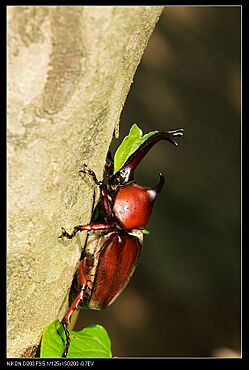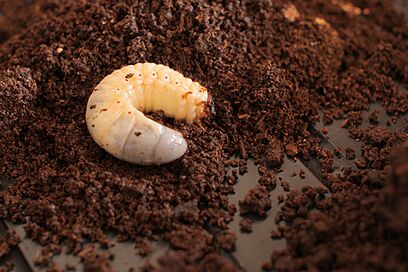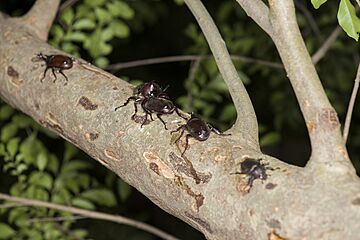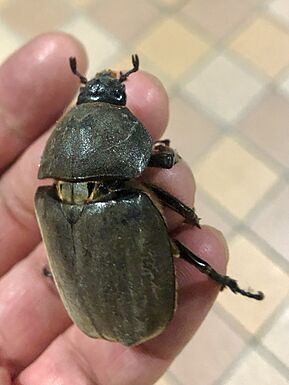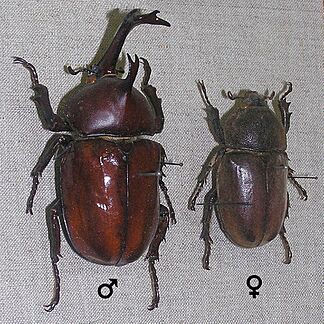Japanese rhinoceros beetle facts for kids
Quick facts for kids Japanese rhinoceros beetle |
|
|---|---|
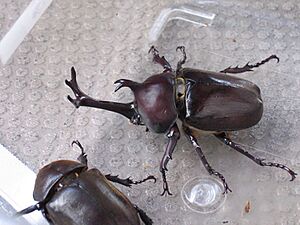 |
|
| Scientific classification | |
| Synonyms | |
|
The Japanese rhinoceros beetle (Allomyrina dichotoma), also known as the Japanese rhino beetle or Japanese horned beetle, is a truly amazing insect. In Japan, it's often called kabutomushi (兜虫 or カブトムシ). These beetles are found across many parts of Asia, including countries like China, Korea, Japan, Vietnam, and Taiwan. They usually live in broad-leaved forests where the climate is warm, either tropical or subtropical.
Male Japanese rhinoceros beetles are famous for the large, impressive horn on their head. They use this horn to fight other males. These fights are usually about protecting their territory and finding female partners. When they fight, males try to flip each other onto their backs or push them off a tree. Interestingly, smaller male beetles have learned clever ways to avoid these big fights and still find a partner.
Contents
What Do They Look Like?
These beetles have a dark brown and red color. Sometimes, without direct light, their bodies can look almost black. Males are typically larger, measuring between 40 and 80 millimeters (about 1.5 to 3 inches) long. Females are a bit smaller, usually growing to be 35 to 60 millimeters (about 1.4 to 2.4 inches) long.
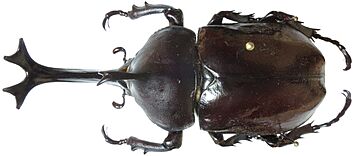
Male A. dichotoma beetles have a very noticeable horn that sticks out from their head. This horn can be as long as one-third of their entire body! Only the males grow this horn, which is a special feature that makes males and females look different. The horn is usually thin and shaped like a pitchfork. It acts like a lever, helping them in their fights with other males. Even with such a large horn, male Japanese rhinoceros beetles can still fly well. Males with bigger horns often have larger wings to help them balance and fly.
Where Do They Live?
Japanese rhinoceros beetles are found all over Asia. You can spot them in China, Japan, Taiwan, Vietnam, Myanmar, Laos, India, Thailand, and the Korean Peninsula.
Their Forest Homes
These beetles love to live in forests with broad-leaved trees. They prefer warm, tropical, or subtropical climates. You can also find them in mountainous areas. The size of male beetles and how well their horns work can differ a lot depending on where they live. This suggests that their environment plays a big role in their development.
How They Find Food
Adult Japanese rhinoceros beetles come out of the ground during the summer months, usually from June to August. They like to gather on tree trunks that have been wounded. Trees like Quercus acutissima (Sawtooth Oak) and Quercus serrata (Konara Oak) are common choices. A tree wound happens when other insects bore into the tree, breaking its outer layer. This exposes the sweet, nutrient-rich sap inside. Adult A. dichotoma beetles take advantage of this easy food source and drink the tree sap.
Some types of Japanese rhinoceros beetles, like Trypoxylus dichotomus septentrionalis, can even carve into tree bark themselves! They don't need other insects to make a hole for them. They often do this on Fraxinus griffithii trees, which have thinner bark. They use a part of their head, called the clypeus, like a chisel. They hold onto the tree tightly and move their head back and forth to cut the bark. Sap flows out for a short time, and the beetle can feed. When the sap stops, they start carving again.
The Life Cycle of a Beetle
Female A. dichotoma beetles lay their eggs by scattering them in the rich, decaying plant material (humus) in the soil. This usually happens between July and September. The tiny larvae (baby beetles) eat the humus. They grow through different stages, called instars. By June or July of the next year, they reach their third instar phase and then change into a pupa. The pupa is a resting stage where the beetle transforms. Adult beetles emerge from the soil a few months after this transformation. It takes about one year for a Japanese rhinoceros beetle to grow from an egg into an adult.
Baby Beetle Behavior
Baby Japanese rhinoceros beetles (larvae) stay buried in the soil. They gather together because of special chemical signals. Since they live underground, they can't see each other, so smells and sounds are very important. Studies show that these chemical signals are needed for larvae to group up.
Interestingly, very young larvae (first instar) don't group together. This is because they sometimes eat other young beetles. But older larvae (second and third instar) don't do this, so they gather normally. They don't care if the other larvae are family or not; they just group with other beetles of their kind.
Older larvae often build their pupal cells (where they transform) near other groups of larvae. They recognize the chemicals from other larvae and use these signals to choose their transformation spot. One good thing about grouping is that it can improve their food quality. When many larvae are active, eating and burrowing, it helps helpful tiny organisms in the soil. These organisms make the soil more nutritious for the larvae.
However, there are also downsides to living in groups. It can increase the risk of fungal infections, which can be deadly for the larvae. Also, predators like moles can find and eat them more easily when they are all together.
How They Burrow
A. dichotoma larvae stay hidden in the soil until they are ready to become adults in the summer. Even though they live underground, their body shape isn't perfectly designed for digging. The widest part of a full-grown larva is about 20 millimeters, which creates some resistance as they move through the soil. To overcome this, they use a special spinning technique. Their bodies are C-shaped, and they dig by rotating and kicking soil upwards with their tails. Kicking the soil helps loosen it, making it easier for them to sink into the ground.
How Males Use Their Horns
Male A. dichotoma are known for their aggressive behavior. They often use their large horns to fight other males. These fights are usually about protecting their territory and finding female partners. The battles often happen on the trunks of host trees. The goal is to push the opponent off the tree or flip them onto their back. Scientists have broken down these fights into four main stages.
Different Fighting Styles
Stage 1: The Encounter
This is when two males see each other but haven't touched yet.
Stage 2: Shoving
The males make physical contact and start pushing each other with their horns. This stage is important because the beetles are sizing each other up. Each beetle tries to figure out how big and strong its opponent is. Then, it decides whether to keep fighting or to run away.
Stage 3: Prying
At this point, the males will use their horns to try and flip the other beetle onto its back. Depending on how different their sizes are, they will move on to stage 4a or 4b.
Stage 4: Chasing or Flipping
- Stage 4a: Chasing - If one male is much larger or has a much longer horn, the bigger male will chase the smaller one away. The smaller male will retreat.
- Stage 4b: Flipping - If the males are similar in size or horn length, they will keep fighting until one is flipped over. This takes more time and energy than chasing.
Smart Strategies for Smaller Males
Smaller A. dichotoma males have developed different ways to find partners without getting into direct horn-to-horn combat. These are sometimes called "sneak-like behaviors."
One way is when a smaller male approaches another male who is already with a female. The smaller beetle might try to use its horn to separate the other male from the female. Another strategy is when a smaller male approaches a female who is already facing another male. The smaller male will then try to join the female. A third method happens when two males are fighting over a female, and a third, smaller male tries to join the female while they are busy.
Female Beetle Power
Female A. dichotoma beetles don't have horns as long as the males, but they still have a noticeable horn. While they don't fight by shoving and flipping like males, females do show some aggressive behaviors towards each other. They have been seen using their smaller head horns to head-butt other females. They do this to fight over territory and access to food. Larger females usually have an advantage in these fights.
Similar to the males, smaller females have also developed clever, non-fighting strategies to get food and find partners. If a smaller female is defeated, she might climb onto a larger female. The two females rarely fight after this. The smaller female can then access resources like food.
Why Horns Are Important
The horns on male Japanese rhinoceros beetles are a great example of how special traits can develop over time. Beetles with larger horns often win fights against other males. This means they have a better chance of finding partners. Scientists study how local living conditions and breeding habits affect the size of horns. This helps them understand how these traits evolve.
Differences Between Males and Females
Male and female Japanese rhinoceros beetles look different, especially because of the male's horn. This difference can also affect their safety. Males, with their big horns, are more likely to be caught by predators like birds and raccoons. This suggests that while a big horn helps in finding a partner, it also makes them more visible to dangers. This might keep horns from growing too big, balancing the need to attract partners with the need to survive.
Competition Among Males
Both body size and horn length are important when male A. dichotoma beetles fight. The horn size is the most important factor in predicting who will win. However, a larger horn isn't always the best. A large male with a big horn benefits from fighting to find partners. For these bigger beetles, fighting is their main way to find a partner.
But for smaller Japanese rhinoceros beetles, fighting is not the best strategy. They prefer less confrontational methods, like the "sneak-like behaviors" we talked about. In this case, a smaller beetle might prefer a smaller horn. A smaller horn makes them more mobile and better able to move around without being noticed, especially when larger males are busy fighting. So, horn length can show how good a male is at fighting, but it doesn't always show how good he is at finding a partner.
Studies have shown that there's a wide range of horn lengths among males. This means that one specific horn length isn't always better than others. A large horn is great for fighting, but it can get in the way when the beetle tries to dig into leaves or dirt to hide during the day. A big horn can make digging harder, leaving the beetle open to predators. Larger horns can also make flying more difficult, making it harder for beetles to move towards potential partners. Some studies even suggest that larger horns might be more fragile than smaller ones. Beetles with big horns sometimes lose them from injuries, while beetles with smaller horns might not.
Food and Horn Size
The food a larva eats has a big impact on how much it grows. If a larva doesn't get enough food, it grows slower. This can make the larval stage last longer. Japanese rhinoceros beetles usually only have one generation of offspring during the three summer months. If a larva takes too long to grow, it might miss its chance to become an adult and find a partner.
Low nutrition during the larval stage also leads to smaller eyes, wings, and wing covers in both male and female adult beetles. However, the parts needed for reproduction in males are not affected by how much food the larvae ate. But the male's head and chest horns are very sensitive to larval nutrition. Low food levels can lead to a 50% decrease in chest horn length and a 60% decrease in head horn length.
Beetles and Humans
Popular Pets
Rhinoceros beetles are very popular pets in Japan. In the past, people would catch them from the wild. But now, many beetles are raised in special farms. Their small size and easy care, compared to pets like mammals, have made them a favorite.
Helping Science
A. dichotoma is a very useful insect for scientific research. It's easy to set up a breeding system for these beetles in a lab. Scientists know a lot about how to breed them and raise their young. Japanese rhinoceros beetles can even be raised without soil, which allows researchers to watch their growth without disturbing them. The larvae are also easy to keep for research because they can be stored at low temperatures to stop them from changing into pupae. This control makes them convenient for year-round studies.
Scientists have also developed ways to study specific genes in A. dichotoma. Because these beetles are quite large, scientists can get a lot of DNA and RNA from just one beetle for detailed analysis. The beetle's horn has been especially studied to understand how it grows. Researchers have also found a protein with properties that fight bacteria, and a molecule that might help with certain difficult diseases. This makes A. dichotoma a valuable model for studying animal behavior, how animals interact with their environment, and how they develop over time.
Health Discoveries
The use of Japanese rhinoceros beetles in traditional Chinese medicine has inspired modern research. Scientists have found that compounds from A. dichotoma larvae might have health benefits. For example, some studies suggest they could help with weight management and have properties that fight bacteria.
A. dichotoma has been used in Chinese traditional medicine for almost 2000 years. Research has shown that extracts from A. dichotoma larvae can reduce the activity of genes linked to fat creation. This suggests that Japanese rhinoceros beetle larvae could potentially be a food source to help with obesity. Another study found two proteins in A. dichotoma larvae that fight bacteria. These proteins are effective against tough bacteria like MRSA, which is hard to treat with regular antibiotics.
A. dichotoma larvae eat rotting wood and fruits, so scientists thought they might produce special plant-based chemicals called phytochemicals. These chemicals can help protect against bacterial and viral infections. Researchers found that A. dichotoma extract has moderate antioxidant properties. This means compounds in the larvae can help protect the body from harmful substances. Since people are looking for natural ways to reduce toxins and prevent food spoilage, Japanese rhinoceros beetle larvae extract could be a natural alternative.
Beetles in Pop Culture
Insects are a big part of Japanese Akihabara culture. Japanese rhinoceros beetles have appeared in popular video games like Dragon Quest, which features three monsters that look like A. dichotoma. They have also been shown as vehicles in animated series. In Time Bokan, a children's TV show from the 1970s, the main characters had a time machine that looked like a rhinoceros beetle, complete with the iconic horn.
In Mega Man X3, a boss character named Gravity Beetle was modeled after the rhinoceros beetle. The beetle also appeared in Mushihimesama. The main character in that game befriends a large rhinoceros beetle to defeat enemy insects. Another game, Air, a popular visual novel, features a female rhinoceros beetle. The main character, Miss Misuzu Kamio, befriends this beetle at the start of the game and carries it with her throughout the story. A. dichotoma is truly an iconic insect found throughout Japanese culture.
An Unusual Food Source
A. dichotoma larvae are edible and are known to be very nutritious. The larvae of this species are commonly eaten in East Asia. However, many people don't like eating them because of their strong, unpleasant flavor. The main chemicals causing these flavors are called indoles.
Several studies have looked into ways to make A. dichotoma larvae taste better. One study found that using yeast to ferment larva powder could reduce the bad indole flavor. It also increased flavors that taste like fruit. Another study discovered that using lactic acid fermentation with bacteria could also improve the larvae's taste.


